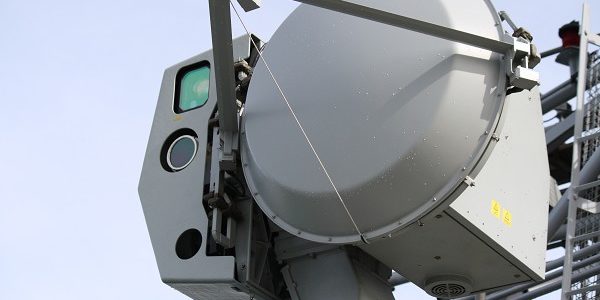Quick Facts
| Role and Mobility | Threat Detection & Tracking; Ship-based |
| Frequency | Ku-band, 15.5-17.5 GHz |
| Range | Long-range |
| Air Defense Interceptor Systems | ESSM and Lockheed Martin Harpoon |
| Targets | Advanced sea skimming missiles and asymmetric surface threats |
| Status/Exports | Operational; Exported to Finland, Norway, South Korea, Australia, New Zealand, Denmark, Canada, and Thailand |
| Producer | Saab Group (Sweden) |
Overview
Saab’s CEROS (Celsius Tech Radar and Optronic Site) 200 is a ship-based search and tracking radar system capable of engaging targets above supersonic speeds. The CEROS employs a variety of sensors such as infrared, electrooptical, televisual, and laser. According to a publication by Saab, CEROS is able to detect sea-skimming missiles via its patented CHASE algorithm.[i] Saab explains that this algorithm mitigates the effect of multiparty wave interference, which is when signals are sent to a receiver by multiple sources.[ii] For example, a missile may emit a signal to a receiver, which then sends it to command and control at the same time that a signal directly from the missile reaches command and control. In this instant, the two signals would arrive with different phase shifts — think: a sine wave placed in front of another, so that there’s no exact overlap. This can result in the ghosting effect sometimes observed on television in which images appear to have a shadow duplicate on them.
“The Ceros 200 FCS has been integrated on the Visby-class corvettes, ANZAC frigates, Skjold-class fast patrol boats, Finnish Squadron 2000 vessels, Rauma-class ships and Korean PKX-class patrol boats. It has also been selected for Denmark’s Combat Support Ships (CSS).”[iii]
Strategic Implications
The CEROS 200 is a valuable fire control system that offers ships operating the system greater defensive capability against anti-ship warfare, particularly against sea skimming missiles. Utilizing the CHASE algorithm, the CEROS 200 is capable of processing the return signal from the missiles, which is usually a more difficult task due to the missiles’ proximity to the water. Ships operating the CEROS 200 would be able to nullify the multipath effect of the sea skimming to protect themselves.
Recent News
Timeline
May 2016: Lockheed Martin Canada contracts Saab to upgrade Canada’s Halifax-class frigates’ CEROS 200 systems with optronic sensors[iv]
April 15, 2015: Saab gets $165 million contract to provide Danish Knud Rasmussen-class patrol vessels with CEROS 200 units[v]
June 3, 2011: Saab received orders from the Royal Thai Navy for upgrading two Naresuan class frigates with CEROS 200 fire control systems[vi]
December 2003: Saab gets 9.3 million euro contract to provide CEROS 200 units for Finnish Navy’s Squadron 2000 vessels
December 2003: South Korean defense electronics company MteQ Systems Inc. reached $14 million contract with Saab for CEROS 200 units[vii]
December 2001: First order for Saab to provide CEROS 200 units for Finnish Navy’s Squadron 2000 vessels
References
[i] https://saab.com/globalassets/commercial/naval/precision-engagement/weapon-control-systems/ceros-200/9lv_fcs_web.pdf
[ii] Ibid. p. 13
[iii] http://www.deagel.com/Protection-Systems/CEROS-200-FCS_a001438001.aspx
[iv] https://saabgroup.com/media/news-press/news/2016-05/saab-receives-optronic-sensors-order-for-canadian-navy/
[v]http://www.defenseworld.net/news/12716/Saab_Wins__165_Million_Danish_Ceros_200_Tracking_System_Contract#.Wui1Ui-ZO9Y
[vi] http://www.navalanalyses.com/2017/02/naresuan-class-frigates-of-royal-thai.html
[vii] https://globenewswire.com/news-release/2003/12/19/304504/50070/en/Saab-wins-order-from-South-Korea-worth-14-million-USD.html

